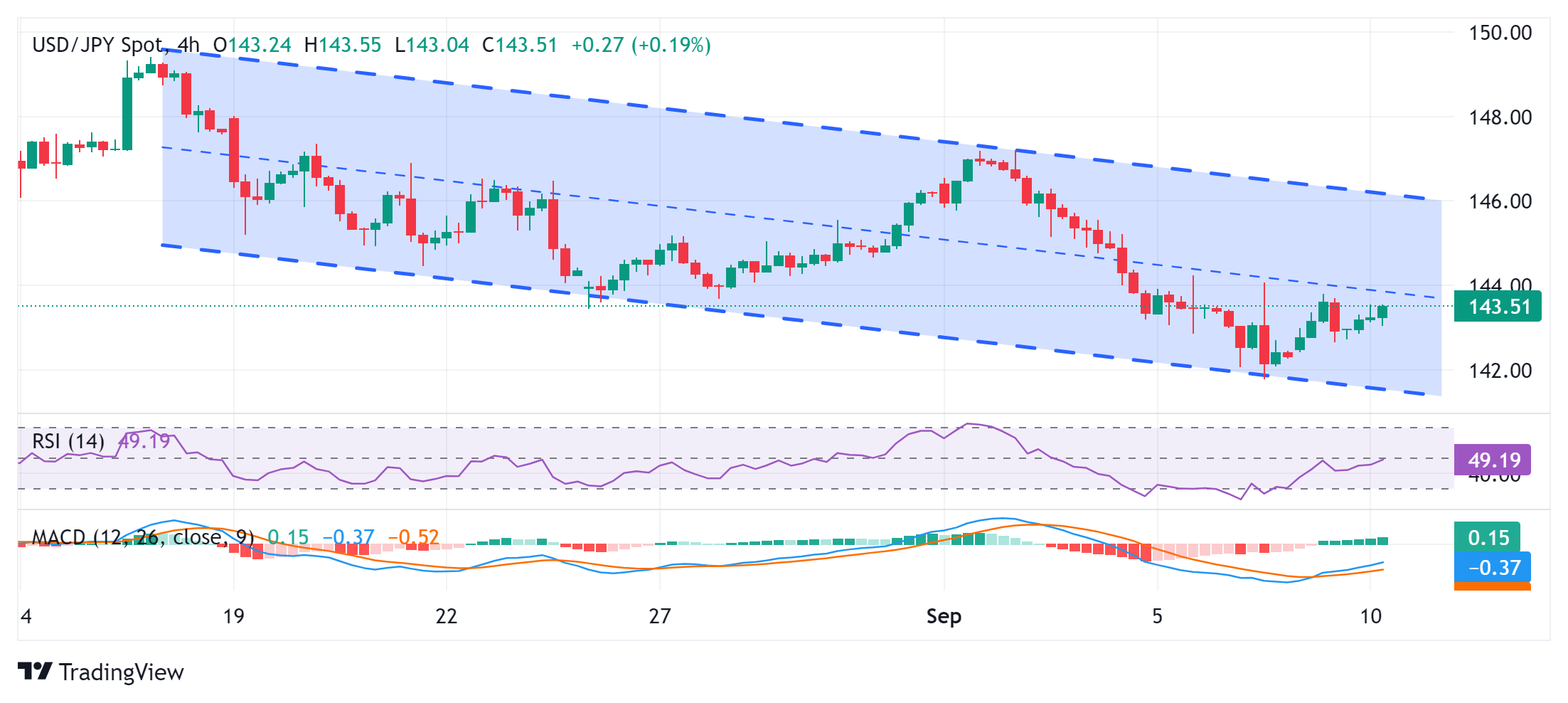- Analiza
- Novosti i instrumenti
- Vesti sa tržišta
- USD/JPY Price Forecast: Sticks to modest gains near mid-143.00s, not out of the woods yet
USD/JPY Price Forecast: Sticks to modest gains near mid-143.00s, not out of the woods yet
- USD/JPY gains positive traction for the second straight day, albeit lacks bullish conviction.
- The formation of a descending channel points to a well-established short-term uptrend.
- A move beyond the 144.00 mark is needed to support prospects for further appreciation.
The USD/JPY pair attracts some buyers for the second straight day on Tuesday and trades around mid-143.00s during the first half of the European session. Spot prices, however, lack bullish conviction and remain below the overnight swing high as traders prefer to wait on the sidelines ahead of the crucial US inflation figures this week.
In the meantime, a downward revision of the second quarter Gross Domestic Product (GDP) print continues to undermine the Japanese Yen (JPY) and acts as a tailwind for the USD/JPY pair amid a modest US Dollar (USD) uptick. That said, the divergent Federal Reserve (Fed)-Bank of Japan (BoJ) policy expectations hold back investors from placing aggressive bullish bets and cap the upside for the currency pair.
From a technical perspective, the recent downfall witnessed over the past four weeks or so has been along a descending channel. This points to a well-established short-term downtrend and supports prospects for the emergence of fresh selling at higher levels. The negative outlook is reinforced by the fact that oscillators on the daily chart are holding deep in negative territory and are still away from being in the oversold zone.
Hence, any subsequent move up might still be seen as a selling opportunity and remain capped near the 144.00 mark. That said, some follow-through buying could trigger a short-covering rally and lift the USD/JPY pair to the next relevant hurdle around the 144.55 region. The momentum could extend further towards reclaiming the 145.00 psychological mark before spot prices climb further toward the 145.60 resistance zone.
On the flip side, the 143.20 area is likely to protect the immediate downside ahead of the 143.00 mark and the Asian session low, around the 142.85 region. Failure to defend the said support levels will reaffirm the negative bias and expose the 142.00 round figure and a seven-month low, around the 141.70-141.65 region touched in August.
USD/JPY 4-hour chart
Japanese Yen FAQs
The Japanese Yen (JPY) is one of the world’s most traded currencies. Its value is broadly determined by the performance of the Japanese economy, but more specifically by the Bank of Japan’s policy, the differential between Japanese and US bond yields, or risk sentiment among traders, among other factors.
One of the Bank of Japan’s mandates is currency control, so its moves are key for the Yen. The BoJ has directly intervened in currency markets sometimes, generally to lower the value of the Yen, although it refrains from doing it often due to political concerns of its main trading partners. The current BoJ ultra-loose monetary policy, based on massive stimulus to the economy, has caused the Yen to depreciate against its main currency peers. This process has exacerbated more recently due to an increasing policy divergence between the Bank of Japan and other main central banks, which have opted to increase interest rates sharply to fight decades-high levels of inflation.
The BoJ’s stance of sticking to ultra-loose monetary policy has led to a widening policy divergence with other central banks, particularly with the US Federal Reserve. This supports a widening of the differential between the 10-year US and Japanese bonds, which favors the US Dollar against the Japanese Yen.
The Japanese Yen is often seen as a safe-haven investment. This means that in times of market stress, investors are more likely to put their money in the Japanese currency due to its supposed reliability and stability. Turbulent times are likely to strengthen the Yen’s value against other currencies seen as more risky to invest in.
© 2000-2025. Sva prava zaštićena.
Sajt je vlasništvo kompanije Teletrade D.J. LLC 2351 LLC 2022 (Euro House, Richmond Hill Road, Kingstown, VC0100, St. Vincent and the Grenadines).
Svi podaci koji se nalaze na sajtu ne predstavljaju osnovu za donošenje investicionih odluka, već su informativnog karaktera.
The company does not serve or provide services to customers who are residents of the US, Canada, Iran, The Democratic People's Republic of Korea, Yemen and FATF blacklisted countries.
Izvršenje trgovinskih operacija sa finansijskim instrumentima upotrebom marginalne trgovine pruža velike mogućnosti i omogućava investitorima ostvarivanje visokih prihoda. Međutim, takav vid trgovine povezan je sa potencijalno visokim nivoom rizika od gubitka sredstava. Проведение торговых операций на финанcовых рынках c маржинальными финанcовыми инcтрументами открывает широкие возможноcти, и позволяет инвеcторам, готовым пойти на риcк, получать выcокую прибыль, но при этом неcет в cебе потенциально выcокий уровень риcка получения убытков. Iz tog razloga je pre započinjanja trgovine potrebno odlučiti o izboru odgovarajuće investicione strategije, uzimajući u obzir raspoložive resurse.
Upotreba informacija: U slučaju potpunog ili delimičnog preuzimanja i daljeg korišćenja materijala koji se nalazi na sajtu, potrebno je navesti link odgovarajuće stranice na sajtu kompanije TeleTrade-a kao izvora informacija. Upotreba materijala na internetu mora biti praćena hiper linkom do web stranice teletrade.org. Automatski uvoz materijala i informacija sa stranice je zabranjen.
Ako imate bilo kakvih pitanja, obratite nam se pr@teletrade.global.
















